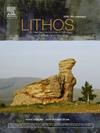Pressure-Temperature-time paths from metapelites reveal Neoproterozoic continental crust underthrusting related to the West Gondwana amalgamation
IF 2.9
2区 地球科学
Q2 GEOCHEMISTRY & GEOPHYSICS
引用次数: 0
Abstract
In this contribution, we employed a petrochronological approach to investigate the tectonometamorphic evolution of Al-rich garnet-staurolite and garnet-staurolite-kyanite (biotite- and plagioclase-free) metapelites of the southernmost portion of the Neoproterozoic Brasília orogen. We have reconstructed the first prograde to peak pressure-temperature-time (P-T-t) paths reported for metamorphic units of the area, by combining petrographic analyses, quantitative compositional mapping of major elements, phase equilibrium modeling, and EPMA Th–U–Pb monazite chemical dating. The metamorphic reactions involved in the prograde metamorphic evolution are discussed, including the effects of garnet fractionation, exhaustion of reactants, and re-equilibration reactions on the major-element composition of garnet porphyroblasts, and their influence on P-T condition estimates. Raman spectroscopy on carbonaceous material (RSCM) thermometry provided insights into the synkinematic retrograde path. A steep prograde path marked by two stages is recorded by the garnet porphyroblasts of garnet-staurolite-muscovite (±kyanite) schists: (i) 555–585 °C and 0.60–0.90 GPa; (ii) 590–635 °C and 1.0–1.4 GPa. Monazite crystals record the prograde to peak path from ca. 630–625 Ma to ca. 605–595 Ma. Matrix graphite crystals suggest post-peak cooling to 400–500 °C concurrent with the late stages of development of the main foliation. The reconstructed P-T-t paths indicate an intermediate dT/dP metamorphism, and a burial rate of ∼0.55 km/Ma, with garnet compositional zoning suggesting that the high-pressure P-T-t path resulted from a single metamorphic event. The corresponding geothermal gradients, and in-situ ages, combined with regional evidence, suggest that peak metamorphic conditions were attained during collisional underthrusting of the continental crust related to the West Gondwana amalgamation.
来自元古岩的压力-温度-时间路径揭示了与西冈瓦纳混杂有关的新近纪大陆地壳下推作用
在这篇论文中,我们采用岩石年代学方法研究了新新生代巴西利亚造山带最南端富铝石榴石-陶粒岩和石榴石-陶粒岩-榍石(不含生物岩和斜长石)变质岩的构造-变质演化。我们结合岩相分析、主要元素定量成分制图、相平衡建模和 EPMA Th-U-Pb monazite 化学年代测定,重建了该地区变质岩单位的首个从顺行到峰值的压力-温度-时间(P-T-t)路径。讨论了级变质演化过程中涉及的变质反应,包括石榴石分馏、反应物耗竭和再平衡反应对石榴石斑岩主要元素组成的影响,及其对 P-T 条件估算的影响。碳质材料上的拉曼光谱(RSCM)测温法提供了对同步逆行路径的深入了解。石榴石-白云石-莫斯卡维石(±斜长石)片岩的石榴石斑晶记录了两个阶段的陡峭逆行路径:(i) 555-585 °C,0.60-0.90 GPa;(ii) 590-635 °C,1.0-1.4 GPa。独居石晶体记录了从约 630-625 Ma 到约 605-595 Ma 的顺行至峰值路径。基质石墨晶体表明,峰后冷却至 400-500 °C,与主褶皱的后期发展阶段同时发生。重建的P-T-t路径显示了中间的dT/dP变质作用,埋藏率为∼0.55 km/Ma,石榴石成分分带表明高压P-T-t路径来自单一变质事件。相应的地热梯度和原位年龄,结合区域证据,表明变质峰值条件是在与西冈瓦纳混杂有关的大陆地壳碰撞下推过程中达到的。
本文章由计算机程序翻译,如有差异,请以英文原文为准。
求助全文
约1分钟内获得全文
求助全文
来源期刊

Lithos
地学-地球化学与地球物理
CiteScore
6.80
自引率
11.40%
发文量
286
审稿时长
3.5 months
期刊介绍:
Lithos publishes original research papers on the petrology, geochemistry and petrogenesis of igneous and metamorphic rocks. Papers on mineralogy/mineral physics related to petrology and petrogenetic problems are also welcomed.
 求助内容:
求助内容: 应助结果提醒方式:
应助结果提醒方式:


